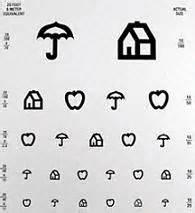According to the American Optometric Association (AOA), infants should have their first eye exam at 6 months of age. Children then should have additional eye exams at age 3, and just before they enter the first grade — at about age 5 or 6.
For school-aged children, the AOA recommends an eye exam every two years if no vision correction is required. Children who need eyeglasses should be examined annually or as recommended by their eye doctor.
The AOA stresses early eye exams for children because 5 to 10 percent of preschoolers and 25 percent of school-aged children have vision problems. Early eye exams also are important because children need the following basic skills related to good eyesight for learning:
- Near vision

- Distance vision
- Binocular (two eyes) coordination
- Eye movement skills
- Hand-eye coordination
- Focusing skills
- Peripheral awareness
For these reasons, some states require a mandatory eye exam for all children entering school for the first time.
The American Academy of Ophthalmology (AAO) says on its Web site that your family doctor or pediatrician likely will be the first medical professional to examine your child’s eyes. If eye problems are suspected during routine physical examinations, a referral might be made to an eye doctor for further evaluation. Eye doctors have specific equipment and training to assist them with spotting potential vision problems.
Babies should be able to see as well as adults in terms of focusing ability, color vision and depth perception by 6 months of age. To assess whether a baby’s eyes are developing normally, the doctor typically will use the following tests:
- Tests of pupil responses evaluate whether the eye’s pupil opens and closes properly in the presence or absence of light.
- “Fixate and follow” testing determines whether your baby’s eyes are able to fixate on and follow an object such as a light as it moves. Infants should be able to fixate on an object soon after birth and follow an object by the time they are 3 months old.
- Preferential looking involves using cards that are blank on one side with stripes on the other side to attract the gaze of an infant to the stripes. In this way, vision capabilities can be assessed without the use of a typical eye chart.
Preschool-age children do not need to know their letters in order to take certain eye tests. Some common eye tests used specifically for young children include:
- LEA Symbols for young children are similar to regular eye tests using charts with letters, except that special symbols in these tests include an apple, house, square and circle.
- Retinoscopy is a test that involves shining a light into the eye to observe the reflection from the back of the eye
- Random Dot Stereopsis testing uses special patterns of dots and 3-D glasses to measure how well your child’s eyes work together as a team.
AAO offers the following reminders:
- Appropriate vision testing at an early age is vital to insure your child has the visual skills he or she needs to perform well in school.
- A child who is unable to see print or view a blackboard can become easily frustrated, leading to poor academic performance.
- Some vision problems, such as lazy eye, are best treated if they are detected and corrected as early as possible while the child’s vision system is still developing.


